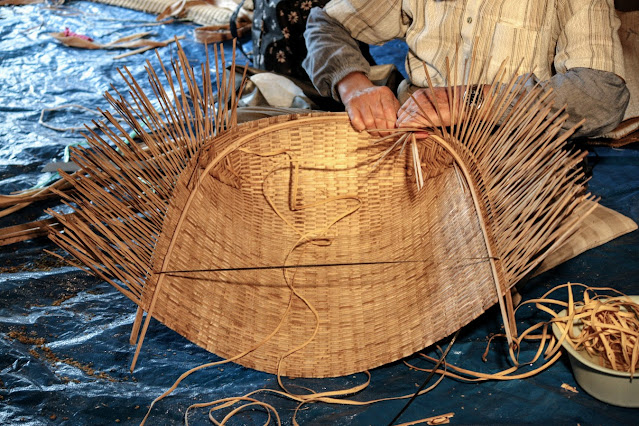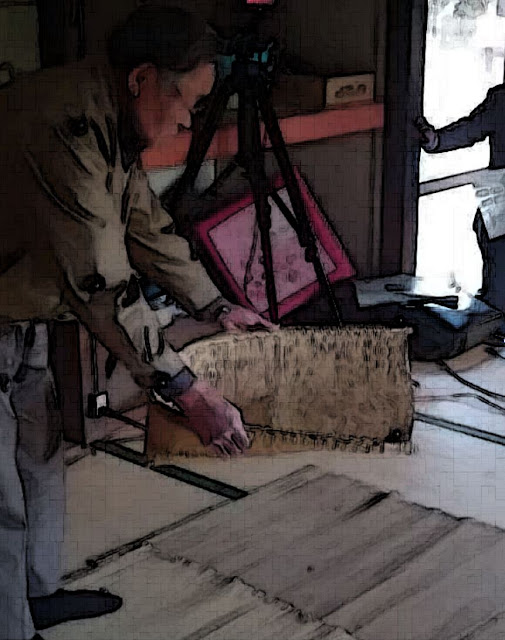千葉県匝瑳市木積の藤箕から Winnowing Basket Made of Japanese Wisteria’s Bark in the Kizumi District in Sosa City, Chiba Prefecture
大利根分館の木積の藤箕
この箕が最初に箕として認識したものです。資料館の近くでとても人懐こいアヒル(かな)が散歩をしていたのが記憶に残っています。この箕の形のバランスの良さに感動を覚えた記憶もあります。ちょうど持ち合わせた3Dカメラで簡易計測をしたものが上の写真です。全体と部分に幾何学的なリズムを感じ取ることができる形です。この時は,その理由は分からず,ただただ年甲斐もなく形に喜び,アヒルに喜んでいたような気がします。
This winnowing basket is the first one I recognized as such. I remember a very friendly duck taking a walk near the museum. I also remember being impressed by the good balance of this winnowing basket’s form. The picture above shows the winnowing basket I simply measured with a three-dimensional camera at hand. Its shape gives a feeling of geometric rhythm in the entirety and parts. I feel that on this occasion I just felt happy about the shape and the duck like a child for a reason I did not know.
さて,ここでの目的は,ひたすら箕の形を再現することでした。木積の藤箕に関しては,イタミ実物を触らせていただくチャンスもあり,下の写真のようにアクドを立てる前のイタミを広げた状態でトレースしてみました。
My purpose on my journey was to recreate the form of winnowing basket. For a winnowing basket made of Japanese wisteria’s bark in the Kizumi district, I got an opportunity to touch its itami, a board-shaped structure made by weaving thin bamboo sticks made of the torn outer skin of thin straight bamboo and skinned Japanese wisteria.
As shown in the picture below, I traced the winnowing basket by stretching itami before erecting akudo, the stand-up part on the exact opposite side of the opening at the front of a winnowing basket.
木積の藤箕のイタミとイタミトレース(赤線)
この赤線図のみを取り出し,少しだけコメントを付したのが
です。上のキャプションからA4サイズの型紙を印刷することができると思いますので,東北の樹皮箕同様に再現してみてください。資料館でみた藤箕は,良い感じで年月を経ているためにイタミの底の曲面がとれ,特にミサキ付近ではきれいな平面となっています。あとになって気が付くのですが,このミサキの形から,その箕が,どのような使われ方をしてきたのか,どのように時間を積み重ねてきたのかが伺い知れそうな傾向にあります。
I took only the red part and added a few comments. Because probably you can print A4-sized patterns from the caption above, I recommend that you recreate the winnowing basket as well as a winnowing basket made of bark in Japan’s northern Tohoku District. For the winnowing basket made of Japanese wisteria’s bark I saw at the museum, as time went by, the curved surface on the bottom of itami was nicely smoothed and showed a neat plane particularly around misaki, the edge of the opening at the front of a winnowing basket. As I realized later, the form of misaki suggests how the winnowing basket was used as time passed.
イタミと箕
ウデキの取り付け
この写真にシノダケとフジカワで構成されるゴザ目のイタミの本質的な性質が見えます。アクドを立ち上げ,片口状態となっていますが,ミサキから中央部にかけて素直な弾性曲線が,アクドからミサキに向かう軸を面の向きとする断面に投影されることがイメージできます。写真では,ウデキの開放を抑える紐がかけられていますが,ウデキとの取り付けが終了し,この紐も解かれると,
This picture reveals the essential nature of rush mat-based itami made of Shinodake bamboo (Pseudosasa japonica) and Japanese wisteria’s bark. Akudo stands up and misaki is open. You can image that a simple elastic curve from misaki to the center is projected on the cross section with an axis from akudo to misaki. The picture shows strings fixed to prevent udeki, a U-shaped frame tying a board-shaped structure made by weaving thin bamboo sticks made of the torn outer skin of thin straight bamboo and skinned Japanese wisteria, from opening.
ミサキにはきれいな弾性曲線が見えてきます。おそろしく近似的にみたら,結構サインカーブ ( sin ) に近いものがあり,実際にウデキの両端内側にイタミのミサキ側と同じ長さのアクリル棒を差し込むと,この曲線と同様なカーブを描いてくれます。つまり,この形は弾性曲線的であり,長い棒状の素材がその長軸方向に圧縮を静かに受けるときに現れる自然なカーブとなっているのです。
But if you untie the strings from udeki, a neat elastic curve will show in misaki. In fact, this curve is highly similar to a sine curve; if you insert an acrylic stick the same length as the misaki side of itami into the inside of both ends of udeki, you will see a similar curve to this. That is, this form is like an elastic curve, a natural curve that appears when a long stick-like material is quietly compressed in the direction of its long axis.
木積の藤箕には,ミサキだけでなく,随所にこのようなその形を構成する素材の自然な姿を垣間見ることができるようです。丁寧に素材選択をし,シノダケ一本一本を丁寧に加工し,ひたすら均質に編み上げて行った結果として,全体と部分とのバランスの取れた力の伝達がなされた結果が,この形とも言えるわけです。
It seems that the naturalness of material can be seen everywhere, including misaki, in Kizumi’s winnowing basket made of Japanese wisteria’s bark. It can be said that this form is the crystallization of efforts to select materials carefully, process each piece of Shinodake bamboo meticulously, weave it homogeneously and transmit well-balanced force in the entirety and parts.
さて,工作用紙にコピー用紙に印刷した型紙を貼り付けて,作ってみましょう。作り方は初号機と同じです。イタミもどきの弾性とウデキの跳ね返りを体感しながら抑え込むと,
を得ます。裏側は,こんな感じです。ちなみにコピー用紙だけで作ろうとすると,これと同じ素材のウデキでは,ウデキの力が強すぎて破綻するので,
さらに細い竹ひごに置き換え,ウデキの戻ろうとする力を弱めてみましたが,それでも木積の藤箕特有のミサキ辺りの曲面が再現できません。コピー用紙をイタミとする場合,このサイズでも,U字に曲げられた極細の竹ひごが元の形に戻ろうとする力(復元力)が支配的になっていることが理解できます。つまり,このコピー用紙箕と工作用紙箕との比較においては,工作用紙の弾性と幅5㎜,厚み2㎜の帯状の竹ひごの復元力との力のバランスによって,木積の藤箕もどきを再現することはできそうですと言ってもいいような気がします。
Now, let’s make an imitation of winnowing basket by attaching a pattern printed on copying paper to handicraft paper. This method is the same as the first model. If you hold it sensing the elasticity of an imitation of itami and the resilience of udeki, you can get this form. Look at the back of it. By the way, if you try to make an imitation by only copying paper, you will fail using udeki with the same material because its force is too strong. That is why I switched to a thinner bamboo stick to weaken the resilience of udeki, but I could not recreate a curved surface around misaki peculiar to Kizumi’s winnowing basket made of Japanese wisteria’s bark. If you use copying paper for itami, you can understand that the resilience of a very thin U-shaped bamboo stick is predominant even with this size. That is, I feel that it can be said that in this comparison of a winnowing basket made of copying paper and a winnowing basket made of handicraft paper, you may be able to recreate an imitation of Kizumi’s winnowing basket made of Japanese wisteria’s bark according to the force balance between the elasticity of handicraft paper and the resilience of a belt-shaped bamboo stick 5 millimeters wide and 2 millimeters thick.
表(内側)に貼ると失敗しました(シワができました)
裏(外側)に貼ると見えません(うまくいきました)














コメント
コメントを投稿